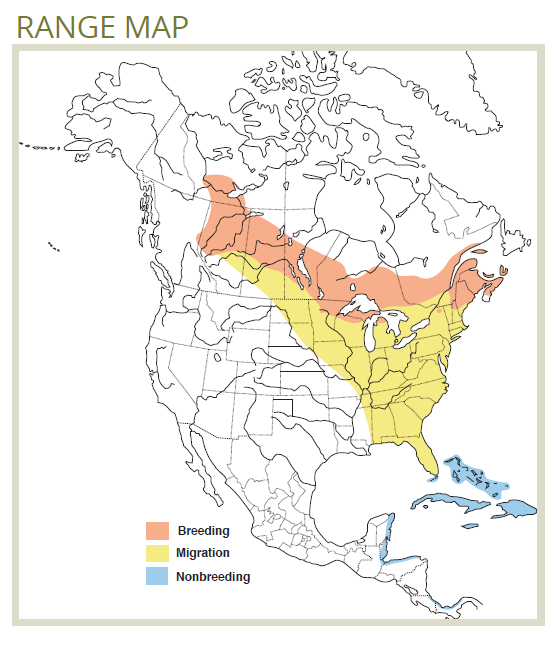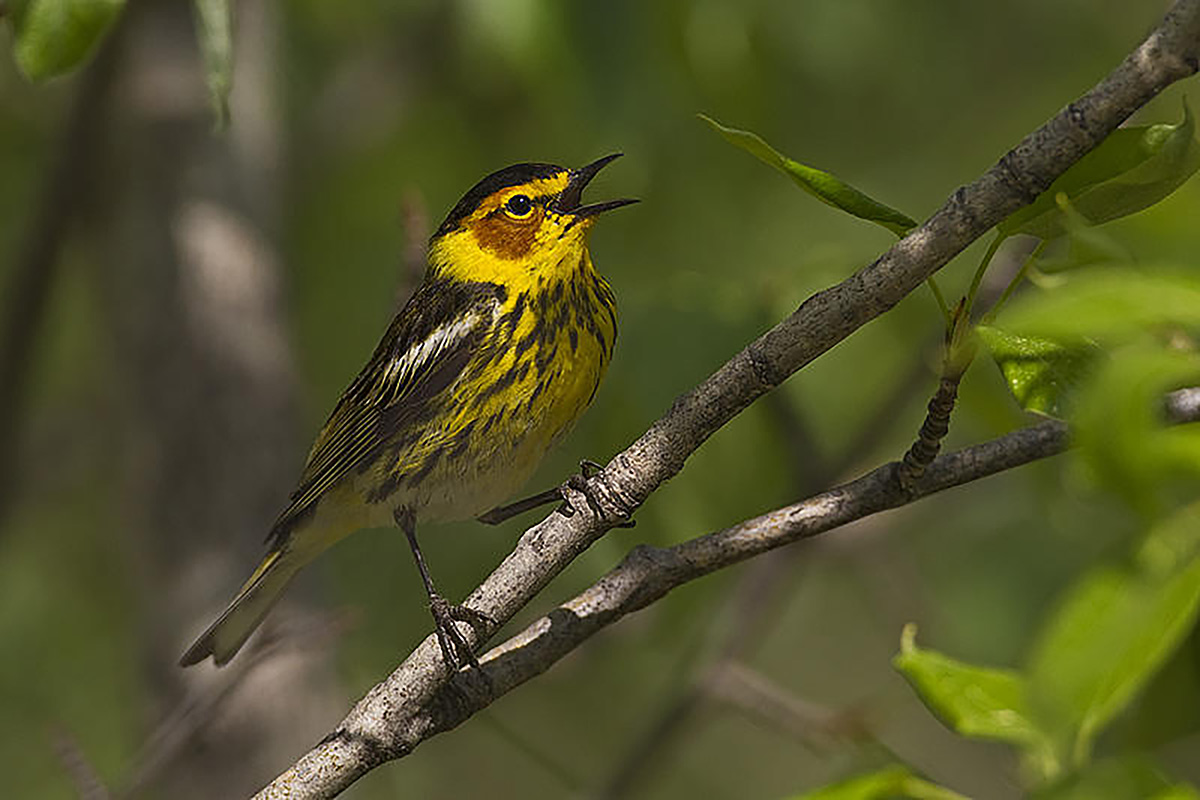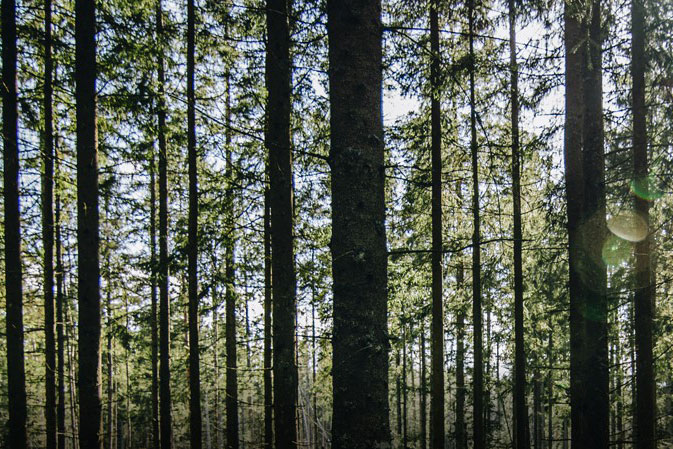Populations of this spruce budworm specialist fluctuate with the booms and busts of budworm outbreaks. Its high-pitched song is easily confused with the Bay-breasted Warbler, another budworm specialist.
Cape May Warbler
(Setophaga tigrina)
Habitat Ecology
- Cape May Warblers are found in old coniferous (>76 years) and conifer-leading mixedwood (>125 years) forests containing spruce and/or balsam fir, particularly stands with spruce >10 m tall with some trees extending above the canopy.1,2
- Important habitat features across their range include an open, mossy understory and richer, wetter sites containing white spruce, balsam poplar, and high alder cover (Saskatchewan).1,3
- Populations of Cape May Warblers increase sharply in areas infested with spruce budworm.1 During outbreaks, they are also found in early-seral forests.4

Response to Forest Management
- Cape May Warblers are very rarely observed in recently disturbed forest stands5 or mid-seral forests.2
- Evidence of use of riparian buffers is mixed for this species. In New England, Cape May Warblers had much lower densities in riparian buffers than unharvested forest.6 In Saskatchewan, Cape May Warblers and other coniferous-associated species used 10 m buffers plus 30 m partially harvested forest, but their abundance compared with unharvested stands was not tested.7
- Cape May Warblers occur at very low densities so there is little information on their responses to different harvest strategies.
Stand-level Recommendations
- Large retention patches containing >10 m tall white spruce may provide some benefit, however their utility has not been tested for this species.
- Large, old forest stands are likely the most important tool for conserving this species (see Landscape-level Recommendations).8
Landscape-level Recommendations
- Large, old white spruce or spruce-leading mixedwood forests are considered the most important habitat for this species.8 Stand sizes >100 ha or larger areas consistent with NRV are recommended. Remnant forest blocks >50 ha are seen as a minimum for this species.9
- Cape May Warbler use of old black spruce forest and treed fens is uncertain based on available research but there may be some value of these forests.5,10
- Spruce budworm outbreak areas may represent opportunities for increasing populations within infested stands.9
- Microbial controls (e.g., Bt) or lepidopteran-specific insecticides (e.g., tebufenozide) are recommended over other chemical insecticides for controlling spruce budworm outbreaks, as chemical insecticides may have unknown toxicity to Cape May Warblers and other budworm-eating species.11
References
- Baltz, M. E. & Latta, S. C. 1998. Cape May Warbler (Setophaga tigrina), version 2.0. in The Birds of North America (Rodewald, P. G., ed.) Cornell Lab of Ornithology, Ithaca, New York, USA. Available online: https://doi.org/10.2173/bna.332
- Schieck, J. & Song, S. J. 2006. Changes in bird communities throughout succession following fire and harvest in boreal forests of western North America: literature review and meta-analyses. Canadian Journal of Forest Research 36: 1299–1318. Available online: https://doi.org/10.1139/x06-017
- Kirk, D. A. & Hobson, K. A. 2001. Bird–habitat relationships in jack pine boreal forests. Forest Ecology and Management 147: 217–243. Available online: http://www.sciencedirect.com/science/article/pii/S0378112700004655
- Venier, L. A., Pearce, J. L., Fillman, D. R., McNicol, D. K. & Welsh, D. A. 2009. Effects of Spruce budworm (Choristoneura fumiferana (Clem.)) outbreaks on boreal mixed-wood bird communities. Avian Conservation and Ecology 4: 3.
- Norton, M. R. 2001. Status of the Cape May Warbler (Dendroica tigrina) in Alberta. Alberta Environment, Fisheries and Wildlife Management Division, and Alberta Conservation Association, Wildlife Status Report No. 33, Edmonton, AB. 20 pp.
- Meiklejohn, B. A. & Hughes, J. W. 1999. Bird communities in riparian buffer strips of industrial forests. American Midland Naturalist 141: 172–184. Available online: http://www.jstor.org/stable/10.2307/2426975
- Kardynal, K. J., Hobson, K. A., Van Wilgenburg, S. L. & Morissette, J. L. 2009. Moving riparian management guidelines towards a natural disturbance model: An example using boreal riparian and shoreline forest bird communities. Forest Ecology and Management 257: 54–65.
- Cooper, J. M., Enns, K. A. & Shepard, M. G. 1997. Status of Cape May warbler in British Columbia. B.C. Environment Wildlife Working Report WR-82: B.C. Ministry of Environment, Lands and Parks, Wildlife Branch. Wildlife Working Report No. WR-82, Victoria, B.C. 37 pp.
- Alberta Environment and Sustainable Resource Development. 2014. Black-Throated Green Warbler, Bay-Breasted Warbler and Cape May Warbler Conservation Management Plan 2014-2019. Alberta Environment and Sustainable Resource Development. Species at Risk Conservation Management Plan No. 10, Edmonton, AB. 33 pp.
- ABMI. 2017. Cape May Warbler (Setophaga tigrina). ABMI Species Website, version 4.1 Available online: http://species.abmi.ca/pages/species/birds/CapeMayWarbler.html
- Environment Canada. 2013. Bird Conservation Strategy for Bird Conservation Region 6: Boreal Taiga Plains. Canadian Wildlife Service, Environment Canada, Edmonton, Alberta. 288 pp.








